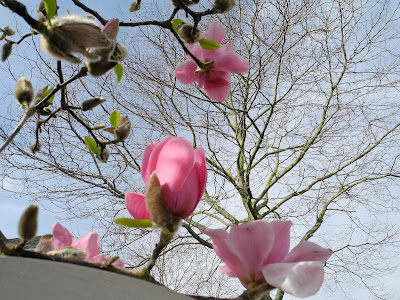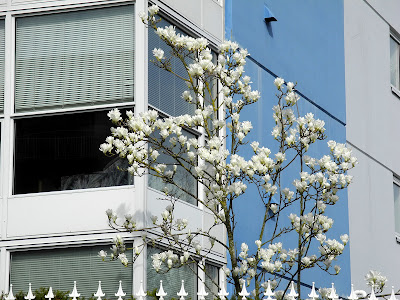Tuesday was warm and bright, with portents of coming rain in the high clouds. A perfect day for working outdoors, flavoured with a hint of urgency; it could be the last for a while. In the afternoon, while Laurie planted onion sets and transplanted a row of leeks, I took the car down to the car wash for its spring cleaning, a job I love on a warm day. I took my time getting every cranny scrubbed and vacuumed, so it was near supper time when I headed home. My route took me past a housing development where we've been keeping an eye on a magnolia that promised a good crop of flowers this year. And there it was, in the first flush of full bloom.
At home, I found Laurie still in the garden, muddy and looking a little weary. "Grab your camera and come with me," I told him. After a feeble protest, and a change of boots, he did.
 |
| We couldn't find parking close to our tree, and ended up under this cherry tree a couple of blocks away. |
 |
| Deep pink magnolia on the far side of a wall |
 |
| "Our" tree, in the corner of a yard, surrounded by various shrubs. |
 |
| The blossoms were at their best, with few of the brown spots and broken petals that appear only a day or so later. |
 |
| This one was a good 10 inches across; possibly the largest magnolia flower I've yet seen. |
 |
| Bud, breaking through the "mouse fur" case. I love the textures of the stem and outer bud covers. (Click for full size.) |
 |
| More texture. With petals this size, we get to notice how the colour is laid down; in little pink dots on the white background. (See full size.) |
 |
| Center of the flower. Each stamen is white with a red line down one side. The central clump of pistils will remain when the rest of the flower drops and bright red seeds will burst through its walls. |
 |
| Towering white magnolia, further down the block. |
 |
| Another white-flowered tree. |
Magnolias, like the
horsetail, are ancient plants. They've been around since before there were bees, and are built sturdy, to be pollinated by beetles without too much damage.
Fossilised specimens of Magnolia acuminata have been found dating to 20 million years ago, and of plants identifiably belonging to the Magnoliaceae dating to 95 million years ago. (Wikipedia)
Supper was late, and Laurie had to finish up in the garden in the evening. No matter; schedules are made to be broken.
And the next day, it poured rain all day. When we passed the magnolia yesterday afternoon, it was already looking the worse for wear.

I didn't know that about Magnolias. We have some in bloom across from Mom's condo. - Margy
ReplyDelete